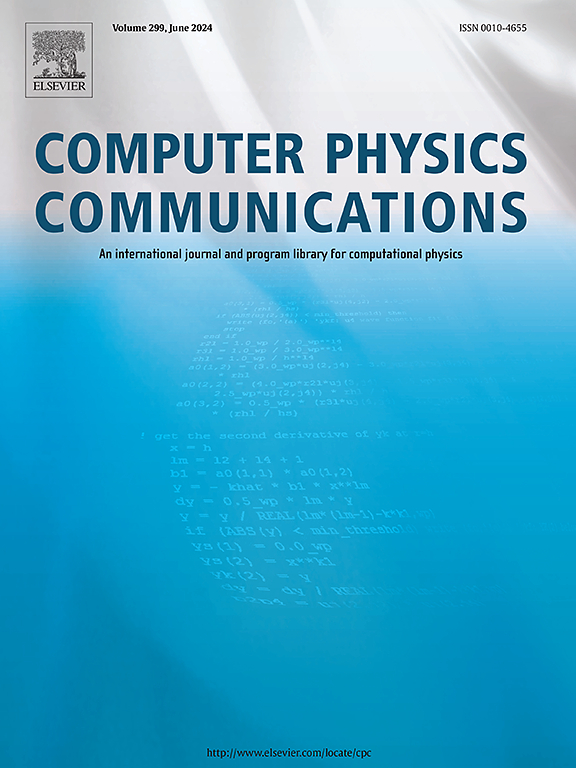六参数耦合系数与广义超几何函数
IF 3.4
2区 物理与天体物理
Q1 COMPUTER SCIENCE, INTERDISCIPLINARY APPLICATIONS
引用次数: 0
摘要
本文将Gaunt系数、Clebsch-Gordan系数以及Wigner 3j和6j符号表示为具有单位参数的广义超几何函数与归一化系数的乘积。利用广义超几何函数的对称性,将这些函数转化为数值可计算的形式,并将归一化系数完全用二项式系数表示。以三个冈特系数的一系列乘积的形式,提出了新的数学表达式,可以用来验证数值计算的准确性。一种算法已开发计算二项式系数和广义超几何函数使用递归关系,消除了需要的阶乘函数。利用该算法和推导出的解析表达式,在不依赖于Mathematica内置函数的情况下,编写了Gaunt_CG_3j_and_6j Mathematica程序,对Gaunt系数、Clebsch-Gordan系数、Wigner 3j和6j符号进行了数值计算。该程序可以很容易地适应其他编程语言,并在所有版本的Mathematica上运行。程序摘要程序标题:Gaunt_CG_3j_and_6jCPC库链接到程序文件:https://doi.org/10.17632/pwhry4278g.1Licensing条款:gplv2编程语言:Wolfram语言(Mathematica 9.0或更高版本)问题性质:本研究将Gaunt系数和Wigner 6j符号解析表达式推导为广义超几何函数和归一化系数的乘积。Wigner 3j符号用Clebsch-Gordan (CG)系数表示的解析表达式在参考文献[27]中以相同的形式给出。本研究引入了新的包含和的解析表达式,以验证将六个参数合并为一个公式的所有耦合系数的数值计算的准确性。Gaunt_CG_3j_and_6j程序对本文和参考文献[27]给出的耦合系数进行数值计算。求解方法:本文将6个参数的耦合系数均表示为带单位参数的广义超几何函数与“归一化”常数的乘积,以二项式系数的形式表示。因此,程序的主要结构是二项式系数的数值计算和单位参数的广义超几何函数。在我们的算法中,基于参考文献[31]中的Eq.(12),使用binomcag和binomcalc模块计算参数包含负整数或正整数的二项式系数。在初始条件F(m,m)=1, F(n,m)=0的条件下,利用递推关系F(n,m)=nn−mF(n−1,m),n≥1,m≥0计算二项式系数,form>n。为了计算六个参数的耦合系数,可以使用广义超几何函数和二项式系数,如本研究所示,作为递归关系或序列表达式和阶乘函数的替代方法。我们在算法中实现了hypergeowhl和hypergeomcal模块来计算广义超几何函数。我们使用参考文献[29]中的Eq.(21)来计算具有单位参数的广义超几何函数。附加注释,包括限制和不寻常的功能:在确定CPU时间时,与我们的程序无关的问题产生于Mathematica。我们用来测量CPU时间的命令行是:x1=TimeUsed[];在以这种方式确定CPU时间时,我们遇到了两个问题。第一个问题发生在我们尝试度量单个耦合系数的计算时间时,其中Mathematica将此时间报告为零(以秒为单位)。为了克服这个问题,我们通过计算单个量子集的1000个或更多耦合系数来计算平均CPU时间。第二个问题来自非零耦合系数(特别是在涉及和的表达式中)的CPU时间,这些系数是不稳定的,并且每次程序运行时都在变化。由于这些结果在多个程序执行中是可重复的,所以我们取计算时间的平均值。长帐面价值本文章由计算机程序翻译,如有差异,请以英文原文为准。
The coupling coefficients with six parameters and the generalized hypergeometric functions
In this study, the Gaunt coefficients, Clebsch–Gordan coefficients, and the Wigner 3j and 6j symbols are expressed as the product of generalized hypergeometric functions with unit argument and a normalization coefficient. By exploiting the symmetry properties of generalized hypergeometric functions, these functions are transformed into numerically computable forms, and the normalization coefficients are fully expressed in terms of binomial coefficients. New mathematical expressions, in the form of a series of products of three Gaunt coefficients, are presented, which can be used to verify the accuracy of numerical calculations.
An algorithm has been developed to compute binomial coefficients and generalized hypergeometric functions using recurrence relations, eliminating the need for factorial functions. Utilizing this algorithm and the derived analytical expressions, the Gaunt_CG_3j_and_6j Mathematica program, which numerically calculates the Gaunt coefficients, Clebsch–Gordan coefficients, and the Wigner 3j and 6j symbols, was written without relying on Mathematica’s built-in functions. The program can be easily adapted to other programming languages and run on all versions of Mathematica.
Program Summary
Program title: Gaunt_CG_3j_and_6j
CPC Library link to program files: https://doi.org/10.17632/pwhry4278g.1
Licensing provisions: GPLv2
Programming language: Wolfram Language (Mathematica 9.0 or higher)
Nature of problem:
In this study, analytical expressions for the Gaunt coefficients and Wigner 6j symbols are derived as the product of generalized hypergeometric functions and a normalization coefficient. Analytical expressions for the Wigner 3j symbols in terms of the Clebsch–Gordan (CG) coefficients are given in the same form in Ref. [27]. This study introduces new analytical expressions involving sums to verify the accuracy of numerical calculations for all coupling coefficients with six parameters consolidated into a single formula. The Gaunt_CG_3j_and_6j program numerically calculates the coupling coefficients presented in this study and Ref. [27].
Solution method:
In this study, all coupling coefficients with six parameters are expressed as the product of the generalized hypergeometric function with unit argument and the “normalization” constant, which is written in terms of binomial coefficients. Therefore, the main structure of our program consists of numerical calculation of the binomial coefficients and generalized hypergeometric functions with unit argument.
In our algorithm, binomial coefficients with parameters containing negative or positive integers are calculated using the binomcag and binomcalc modules, based on Eq. (12) in Ref. [31]. The binomcalc module computes the binomial coefficients using the recurrence relation:with the initial conditions and .
To calculate the coupling coefficients with six parameters, generalized hypergeometric functions and binomial coefficients can be used, as demonstrated in this study, as an alternative to recurrence relations or serial expressions and factorial functions. We implemented the hypergeowhl and hipergeomcal modules in our algorithm to calculate the generalized hypergeometric functions. We used Eq. (21) in Ref. [29] to compute the generalized hypergeometric functions with unit argument.
Additional comments including Restrictions and Unusual features:
When determining CPU times, issues unrelated to our program arise from Mathematica. The command lines we use to measure CPU time are: x1=TimeUsed[];
x2= TimeUsed[]; time=x2-x1
We encountered two problems when determining CPU times in this manner. The first problem occurs when we try to measure the calculation time for a single coupling coefficient, where Mathematica reports this time as zero (in seconds). We calculated the average CPU time by computing 1000 or more coupling coefficients for a single quantum set to overcome this. The second problem arises from the CPU times for non-zero coupling coefficients (particularly in expressions involving sums), which are unstable and vary each time the program is run. Since these results are reproducible across multiple program executions, we take the average of the computed times.
Long write-up
求助全文
通过发布文献求助,成功后即可免费获取论文全文。
去求助
来源期刊

Computer Physics Communications
物理-计算机:跨学科应用
CiteScore
12.10
自引率
3.20%
发文量
287
审稿时长
5.3 months
期刊介绍:
The focus of CPC is on contemporary computational methods and techniques and their implementation, the effectiveness of which will normally be evidenced by the author(s) within the context of a substantive problem in physics. Within this setting CPC publishes two types of paper.
Computer Programs in Physics (CPiP)
These papers describe significant computer programs to be archived in the CPC Program Library which is held in the Mendeley Data repository. The submitted software must be covered by an approved open source licence. Papers and associated computer programs that address a problem of contemporary interest in physics that cannot be solved by current software are particularly encouraged.
Computational Physics Papers (CP)
These are research papers in, but are not limited to, the following themes across computational physics and related disciplines.
mathematical and numerical methods and algorithms;
computational models including those associated with the design, control and analysis of experiments; and
algebraic computation.
Each will normally include software implementation and performance details. The software implementation should, ideally, be available via GitHub, Zenodo or an institutional repository.In addition, research papers on the impact of advanced computer architecture and special purpose computers on computing in the physical sciences and software topics related to, and of importance in, the physical sciences may be considered.
 求助内容:
求助内容: 应助结果提醒方式:
应助结果提醒方式:


